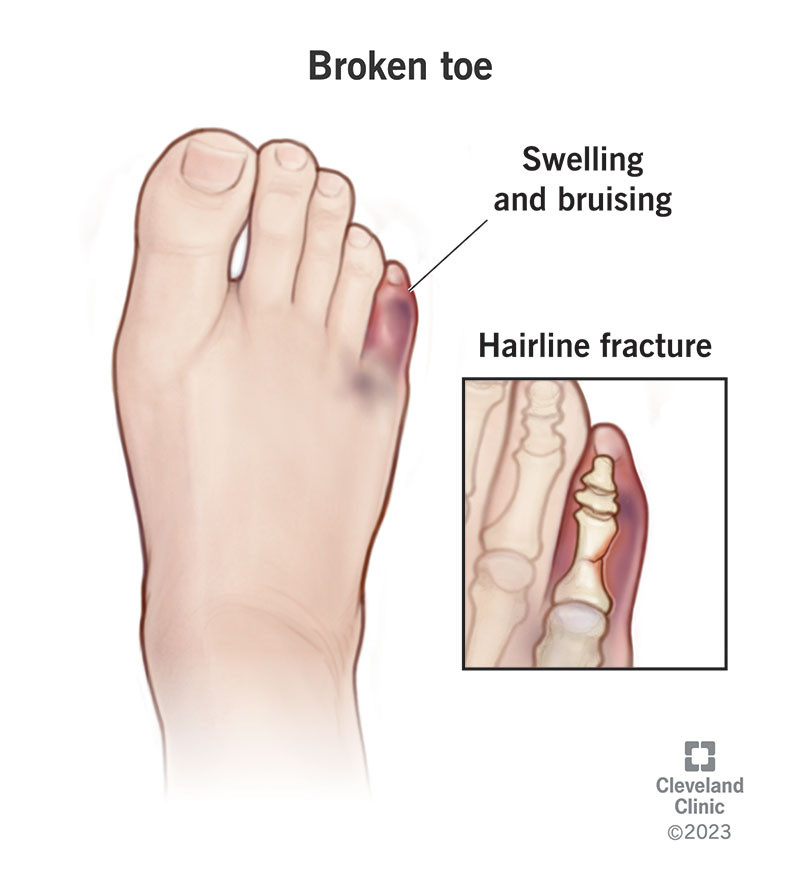A broken toe, or toe fracture, can affect any of your 14 toe bones (phalanges). While these bones are small, a broken toe can be painful and affect the way your foot functions. Most broken toes heal on their own with rest and at-home care, but you should still see a healthcare provider to make sure your injury doesn’t need further treatment.
Advertisement
Cleveland Clinic is a non-profit academic medical center. Advertising on our site helps support our mission. We do not endorse non-Cleveland Clinic products or services. Policy

A broken toe, or toe fracture, is a common injury. The bones in your toes are tiny and vulnerable, so they can break easily. Even though these bones are small, injuries to them can be quite painful. In addition, all the bones in your feet and toes work together when you walk. So, when you break one, it can affect how your feet function.
Advertisement
Cleveland Clinic is a non-profit academic medical center. Advertising on our site helps support our mission. We do not endorse non-Cleveland Clinic products or services. Policy
In most cases, broken toes will heal on their own with rest and some at-home care. But you should see a healthcare provider to evaluate your injury if pain or swelling are severe. More significant injuries may require further medical treatment. Although rare, this may include manipulation to realign your toe in your provider’s office or even surgery.
Foot and ankle surgeons divide toe fractures into two categories: traumatic fractures and stress fractures.
Healthcare providers also classify toe fractures as closed or open:
Advertisement
The most common signs of a toe fracture are throbbing pain and swelling. Other broken toe symptoms may include:
With a traumatic fracture, you may hear a sound when you break it. Your toe may look crooked or have an abnormal appearance. With a stress fracture, you may have swelling but no bruising. The pain may go away when you’re resting but come back when you stand or return to activity.
Toe fractures often result from a direct blow, injury or trauma to your toe bone. This may be from dropping a heavy object on your foot, kicking something really hard or seriously stubbing your toe.
Fractures may also develop after overuse and repetitive activity, instead of a one-time injury. These are called stress fractures. Stress fractures often affect athletes that participate in high-impact sports like football and basketball. They also frequently occur in runners. Other causes of stress fractures include:
If you think you may have a broken toe, it’s important to see a healthcare provider as soon as possible. Without treatment, a broken toe can lead to complications, including:
Your healthcare provider will ask about your symptoms and medical history. They’ll want to know how you injured your toe. They’ll also perform a physical exam, which involves:
Your provider may be able to diagnose a broken toe based on the physical exam alone. However, sometimes, they request imaging tests. These tests may include:
If you have painful symptoms of a broken toe that impair your mobility, you should see a healthcare provider and get an X-ray. While you’re waiting to see your provider, you can do the RICE method at home.
Advertisement
The RICE method involves Rest, Ice, Compression and Elevation:
You may also take pain medication as necessary. You can use nonsteroidal anti-inflammatory drugs (NSAIDs) like ibuprofen or naproxen, or acetaminophen (Tylenol®). Don’t give aspirin to children.
You may find it painful to wear regular footwear. Wearing a wider shoe than normal may be more comfortable.
Broken toe treatment depends on the location of your injury and the type of fracture. Your provider may recommend:
Advertisement
Your initial pain and swelling should go away within a week. Most broken toes take six to eight weeks to heal completely. Depending on the severity of your condition, it could take longer. Your foot could remain swollen for several months.
Your healthcare provider will let you know when it’s safe to return to sports and resume your normal activities. But you should be able to return once your swelling has gone down and you can comfortably wear supportive shoes. Gradually increase the amount of physical activity you do each day.
You may experience some stiffness and soreness when you walk. But this should go away when your toe muscles start to stretch and strengthen. If you begin to experience any new pain, you should stop what you’re doing immediately and reach out to your provider. You don’t want to risk reinjuring yourself.
Because traumatic fractures are due to accidents and injuries, they’re difficult to prevent. However, there are several steps you can take to try to prevent stress fractures:
Advertisement
If you notice any of the following symptoms, reach out to your healthcare provider:
If you sought treatment for your broken toe, you’ll want to follow up with your healthcare provider one to two weeks after your injury. If you have a severe injury, your provider may want to see you more frequently.
Questions you may want to ask your healthcare provider include:
Ouch! You just banged your toe against the door as you were running into the house. Is it broken? Once the pain subsides, you may brush it off and move on to the next thing. It’s just a toe, right? Take another look. While tiny, the bones in your toes are a vital part of how your feet function. You need them working properly to walk, play sports and participate in the other activities you love. So, get some rest, and make a call to your healthcare provider to have any potential toe fractures checked out.
From sudden injuries to chronic conditions, Cleveland Clinic’s orthopaedic providers can guide you through testing, treatment and beyond.

Last reviewed on 12/19/2023.
Learn more about the Health Library and our editorial process.